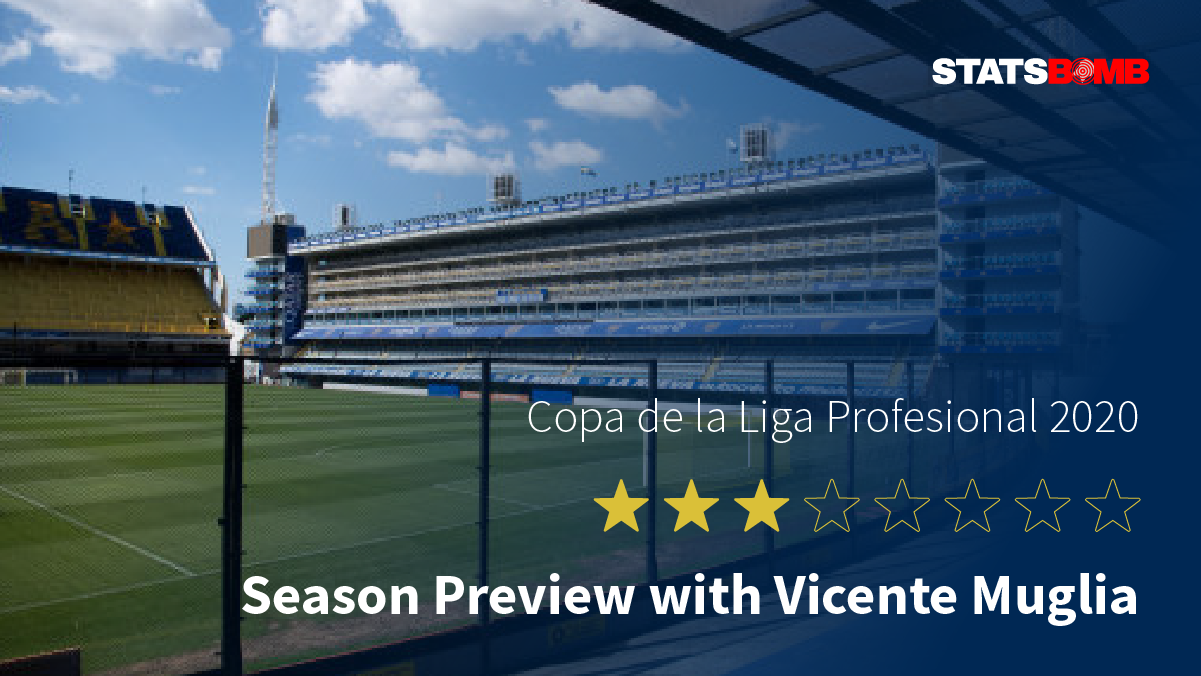Football returns to Argentina this week following a seven-month absence due to the COVID-19 pandemic. Vicente Muglia, Olé journalist and author of the book Che Pep, joins us to preview the Copa de la Liga Profesional 2020, which opens with Gimnasia La Plata against Patronato on Friday. Nick Dorrington, Content Manager at StatsBomb (ND): Hi Vicente. Thanks for giving up your time to speak to us. We are going to kick off with the top two from last season (the Superliga 2019-20), River Plate and the champions Boca Juniors, two teams with differing approaches. Could you summarise the key points of their respective play styles? Vicente Muglia (VM): Throughout Marcelo Gallardo’s tenure, River have stood out as a team who take the initiative in two ways: through possession and with a high press. When they have the ball, they are a dangerous team because they are quite direct, they don’t chain together a lot of passes but instead seek to move forward, take advantage of space or create it, all by means of an unwavering tactical intensity. Without the ball, they have a well-oiled pressing system which is consistently effective in winning it back. The forwards are the team’s first defenders. When they win the ball back in opposition territory, they attack decisively to take full advantage of the transitional phase. ND: It is something that is clearly visible in the data. Last season, River utilised an aggressive high press, with only Argentinos Juniors contesting the ball more intensely in opposition territory. 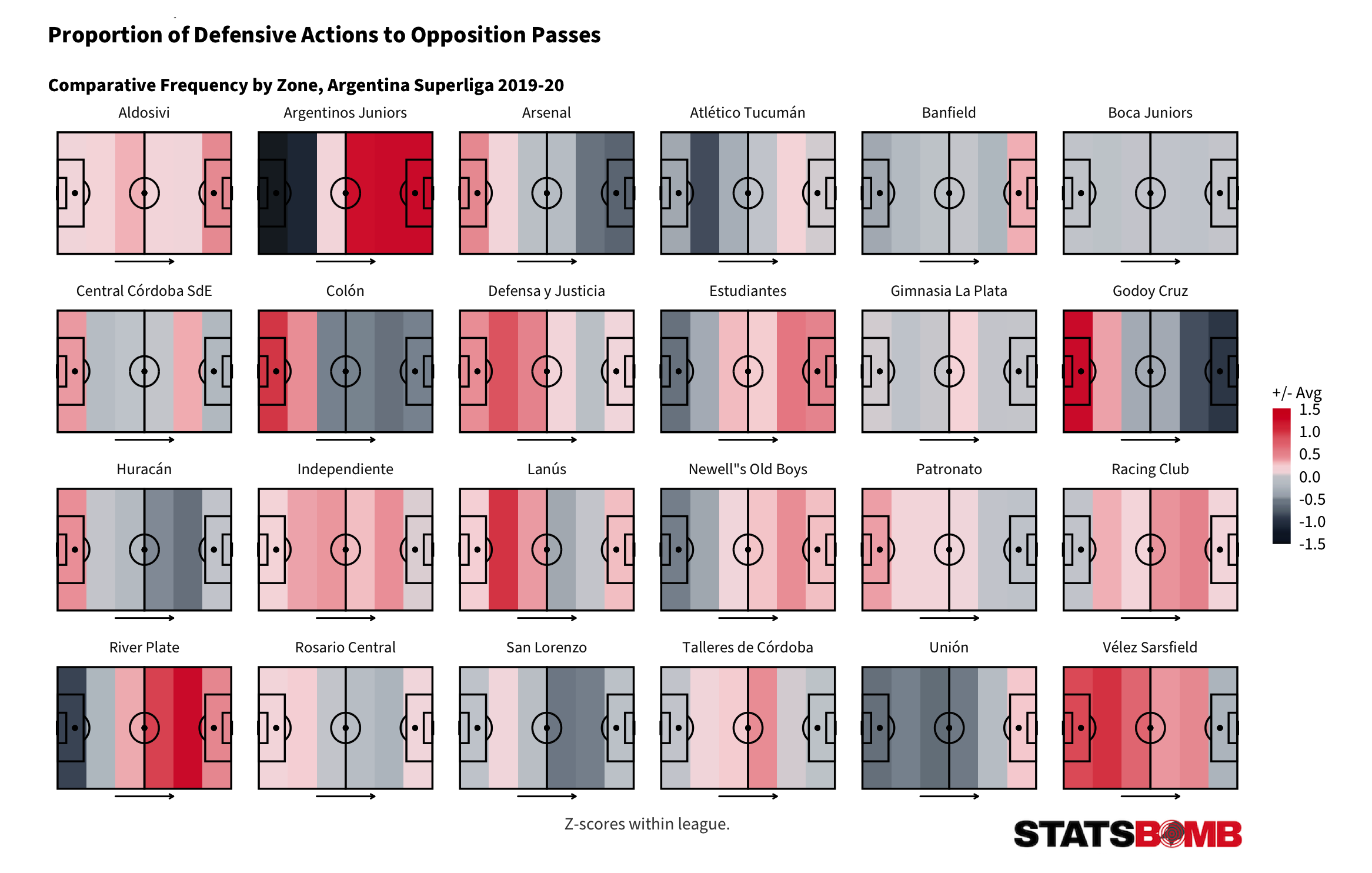 River were also the team who generated the most shots after winning the ball back high up the pitch.
River were also the team who generated the most shots after winning the ball back high up the pitch. 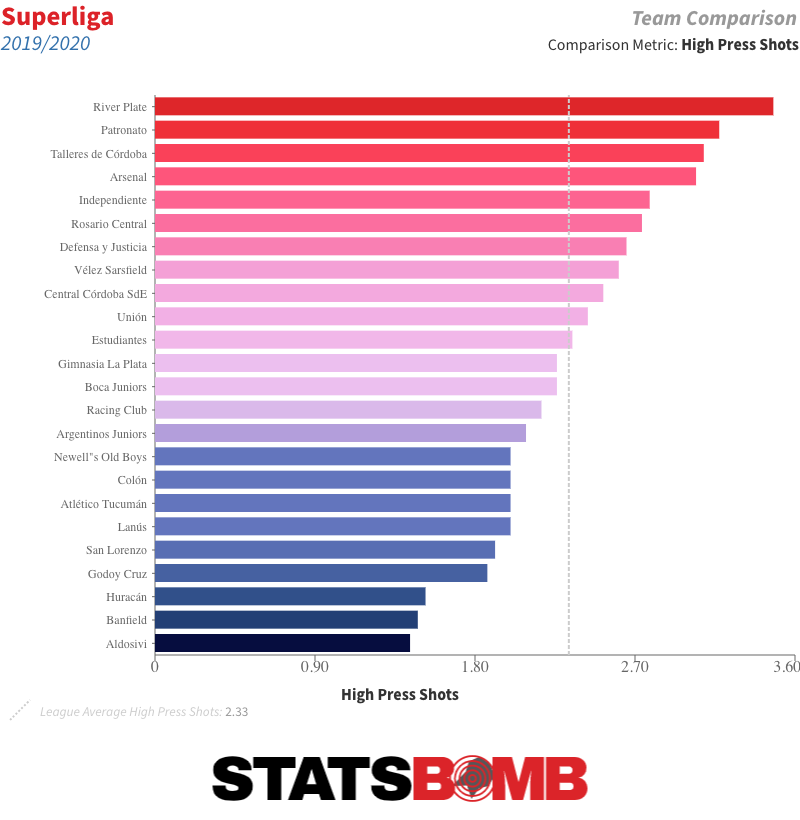 Both visualisations make it clear that Boca, coached by the experienced Miguel Ángel Russo, have a very different play style. VM: Yes. In contrast to River, Boca don’t usually press high but instead focus on winning the ball back in the centre of the pitch and then attacking quickly from there. They are a direct team, who don’t elaborate as much as River. The key to last season’s championship was the damage they did down the flanks. Julio Buffarini and Eduardo Salvio on the right and Frank Fabra and Sebastián Villa on the left spread the pitch, got in behind and destabilised opposing defences. Boca also had the very steady Jorman Campuzano in midfield, and Carlos Tévez up front, who was intelligent in finding space and rationing his efforts. ND: In addition to being the team’s top scorer, Tévez played a very important role in ball progression. He dropped back to receive and combine with teammates, and on a per-90 basis, only Emanuel Reynoso, now of Minnesota United in MLS, moved the ball into the final third more often and played more open play passes into the penalty area than Tévez.
Both visualisations make it clear that Boca, coached by the experienced Miguel Ángel Russo, have a very different play style. VM: Yes. In contrast to River, Boca don’t usually press high but instead focus on winning the ball back in the centre of the pitch and then attacking quickly from there. They are a direct team, who don’t elaborate as much as River. The key to last season’s championship was the damage they did down the flanks. Julio Buffarini and Eduardo Salvio on the right and Frank Fabra and Sebastián Villa on the left spread the pitch, got in behind and destabilised opposing defences. Boca also had the very steady Jorman Campuzano in midfield, and Carlos Tévez up front, who was intelligent in finding space and rationing his efforts. ND: In addition to being the team’s top scorer, Tévez played a very important role in ball progression. He dropped back to receive and combine with teammates, and on a per-90 basis, only Emanuel Reynoso, now of Minnesota United in MLS, moved the ball into the final third more often and played more open play passes into the penalty area than Tévez. 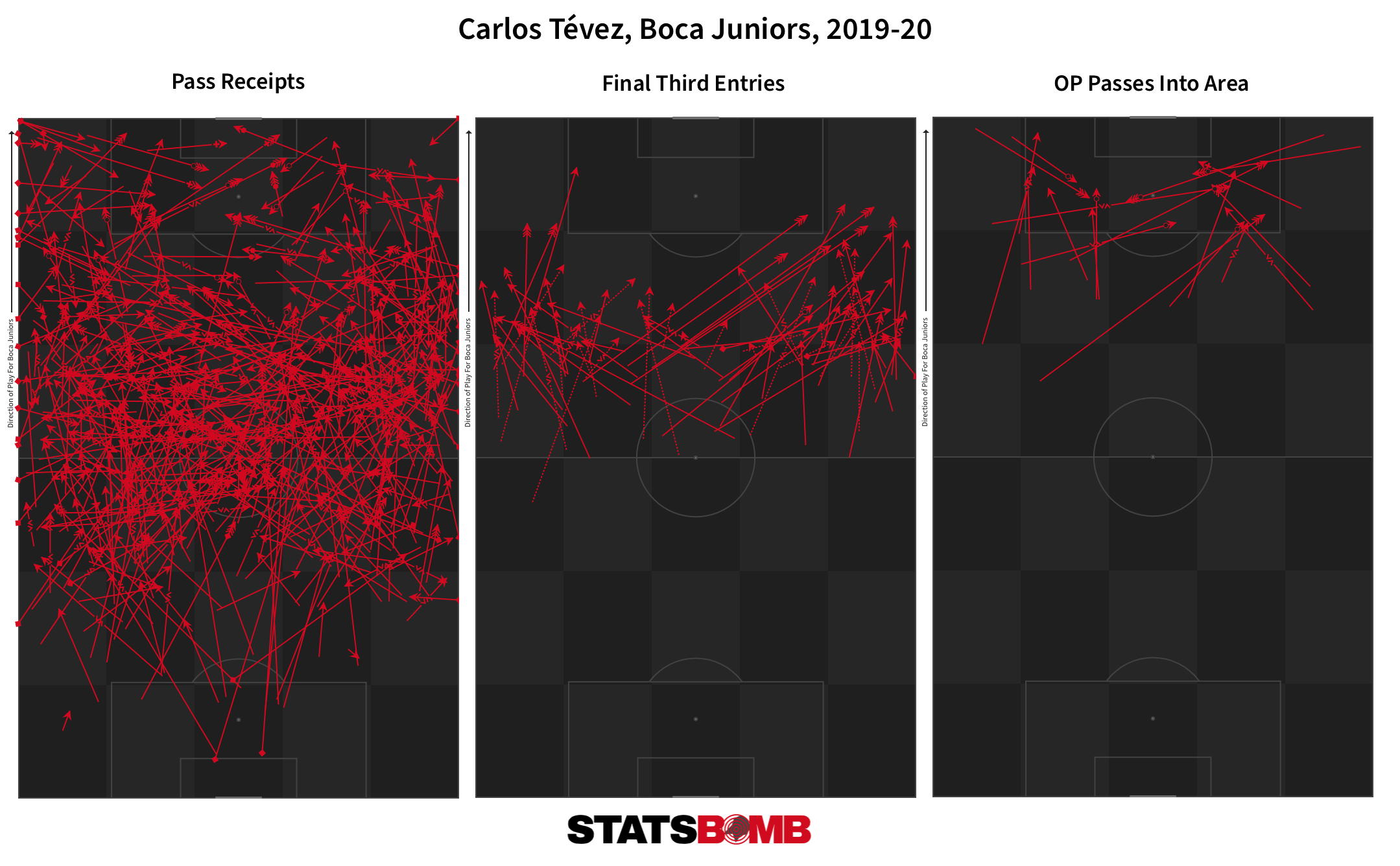 How are Boca and River looking ahead of this tournament? The format is a bit convoluted and so luck is likely to play a larger role than it would in a traditional league format, but are they still the two favourites to win it? VM: Even though River have lost Lucas Martínez Quarta and Juan Fernando Quintero, and Boca are unable to count on Villa due to off-pitch issues, they are still the two strongest teams in Argentinian football both in terms of collective performances and individual quality. They have the two best squads. Without a doubt, they remain the main candidates to lift the trophy. Prior to the start of the tournament, I don’t see another team equipped to compete with them for the trophy in normal conditions. ND: It’s worth mentioning that River had the best expected goal (xG) difference last season, and by some distance.
How are Boca and River looking ahead of this tournament? The format is a bit convoluted and so luck is likely to play a larger role than it would in a traditional league format, but are they still the two favourites to win it? VM: Even though River have lost Lucas Martínez Quarta and Juan Fernando Quintero, and Boca are unable to count on Villa due to off-pitch issues, they are still the two strongest teams in Argentinian football both in terms of collective performances and individual quality. They have the two best squads. Without a doubt, they remain the main candidates to lift the trophy. Prior to the start of the tournament, I don’t see another team equipped to compete with them for the trophy in normal conditions. ND: It’s worth mentioning that River had the best expected goal (xG) difference last season, and by some distance. 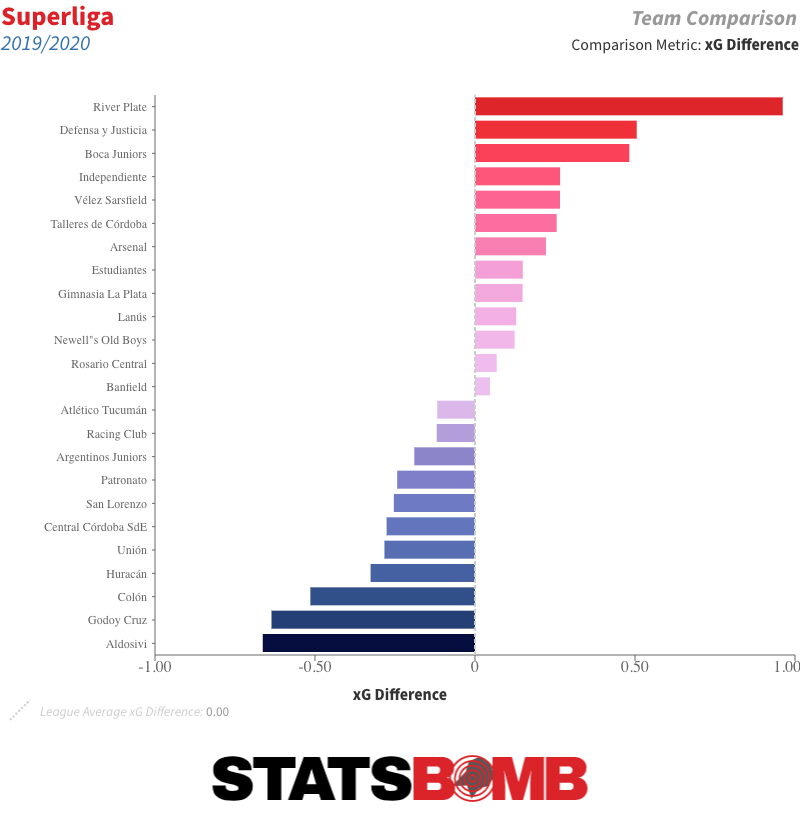 Boca performed well above expectation in defence, letting in just eight goals. Our data suggests the excellent performances of their goalkeeper Esteban Andrada were a contributory factor, but it doesn’t explain all of the difference. It is unlikely they will again concede so few goals.
Boca performed well above expectation in defence, letting in just eight goals. Our data suggests the excellent performances of their goalkeeper Esteban Andrada were a contributory factor, but it doesn’t explain all of the difference. It is unlikely they will again concede so few goals. 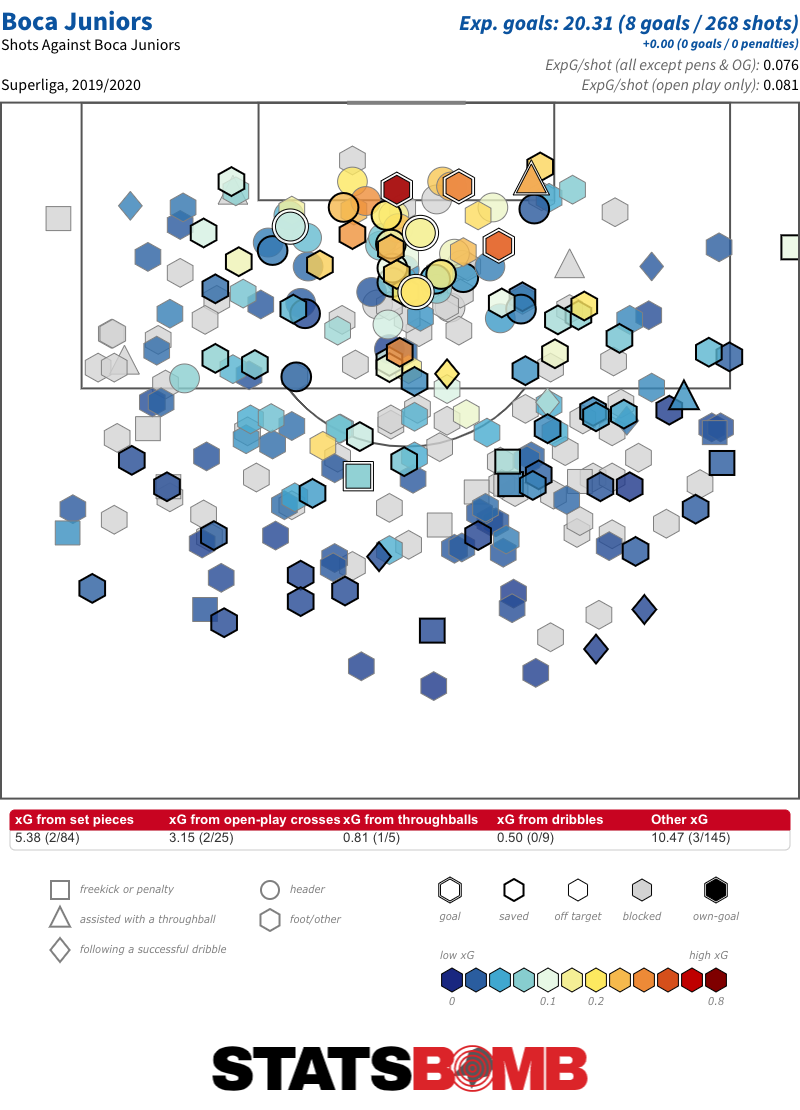 Are there some other teams with interesting play styles? VM: Racing and Defensa y Justicia have a pair of young coaches in Sebastián Beccacece and Hernán Crespo who, despite having different play styles, both seek to take the initiative and attack. They are teams who construct play from the back, move forward and are aggressive in attack. They don’t speculate. Although the feeling is that both of them need to find a bit more consistency, not only in terms of results but also in terms of their play. NM: The underlying numbers suggest that Crespo has better base to work from than Beccacece, but we will see how things play out. Another team who intrigue me are Argentinos Juniors. As we’ve already noted, they utilised a very aggressive high press last season, but they didn’t combine it with a high share of possession. They were a much more direct team than River or Vélez Sarsfield, for example. They finished fifth, but they scored less than a goal per match and struggled to create good quality chances.
Are there some other teams with interesting play styles? VM: Racing and Defensa y Justicia have a pair of young coaches in Sebastián Beccacece and Hernán Crespo who, despite having different play styles, both seek to take the initiative and attack. They are teams who construct play from the back, move forward and are aggressive in attack. They don’t speculate. Although the feeling is that both of them need to find a bit more consistency, not only in terms of results but also in terms of their play. NM: The underlying numbers suggest that Crespo has better base to work from than Beccacece, but we will see how things play out. Another team who intrigue me are Argentinos Juniors. As we’ve already noted, they utilised a very aggressive high press last season, but they didn’t combine it with a high share of possession. They were a much more direct team than River or Vélez Sarsfield, for example. They finished fifth, but they scored less than a goal per match and struggled to create good quality chances. 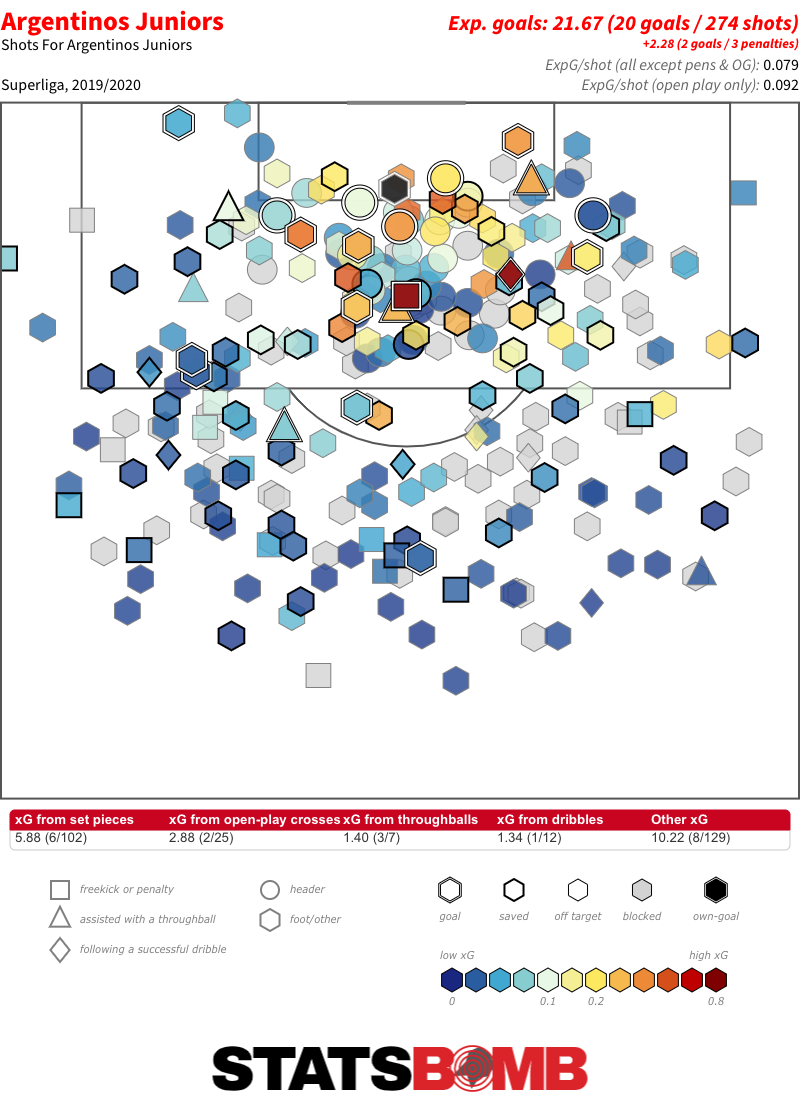 It will be interesting to see if Diego Dabove is capable of developing that aspect of their game. Have there been any interesting coaching changes? VM: Mauricio Pellegrino has replaced Gabriel Heinze at Vélez. It will be a big challenge for the club to maintain the level of competitiveness they had under Heinze, who elevated both the individual and collective level with an approach based around positional play. Pellegrino, returning to the country after a number of years in Europe, is more focused on maintaining balance. He takes less risks. We’ll have to see how the squad adapt to his style. ND: It’s a significant shift. If we take another look at the PPDA by Zone graphic above, we can see that Heinze’s Vélez pressed aggressively across pretty much the entire pitch. It looks very similar to what we see from Marcelo Bielsa’s teams. In contrast, Pellegrino was a much more reactive coach during his time in Spain, although admittedly with smaller teams. VM: There is also Mariano Soso, a young coach with some interesting ideas based around a distinctly attacking approach, who has taken charge at San Lorenzo. There, too, it remains to be seen whether he can convince his players to carry out his game model. ND: Which team made the best moves in the transfer market? VM: Due to the pandemic, there haven’t been many big moves in this window. I think Estudiantes de La Plata made the best signings. They’ve strengthened with Nicolás Pasquini from Lanús, Leonardo Godoy from Talleres de Córdoba and Leandro Díaz from Atlético Tucumán, three footballers who were starters at their respective clubs last season.
It will be interesting to see if Diego Dabove is capable of developing that aspect of their game. Have there been any interesting coaching changes? VM: Mauricio Pellegrino has replaced Gabriel Heinze at Vélez. It will be a big challenge for the club to maintain the level of competitiveness they had under Heinze, who elevated both the individual and collective level with an approach based around positional play. Pellegrino, returning to the country after a number of years in Europe, is more focused on maintaining balance. He takes less risks. We’ll have to see how the squad adapt to his style. ND: It’s a significant shift. If we take another look at the PPDA by Zone graphic above, we can see that Heinze’s Vélez pressed aggressively across pretty much the entire pitch. It looks very similar to what we see from Marcelo Bielsa’s teams. In contrast, Pellegrino was a much more reactive coach during his time in Spain, although admittedly with smaller teams. VM: There is also Mariano Soso, a young coach with some interesting ideas based around a distinctly attacking approach, who has taken charge at San Lorenzo. There, too, it remains to be seen whether he can convince his players to carry out his game model. ND: Which team made the best moves in the transfer market? VM: Due to the pandemic, there haven’t been many big moves in this window. I think Estudiantes de La Plata made the best signings. They’ve strengthened with Nicolás Pasquini from Lanús, Leonardo Godoy from Talleres de Córdoba and Leandro Díaz from Atlético Tucumán, three footballers who were starters at their respective clubs last season. 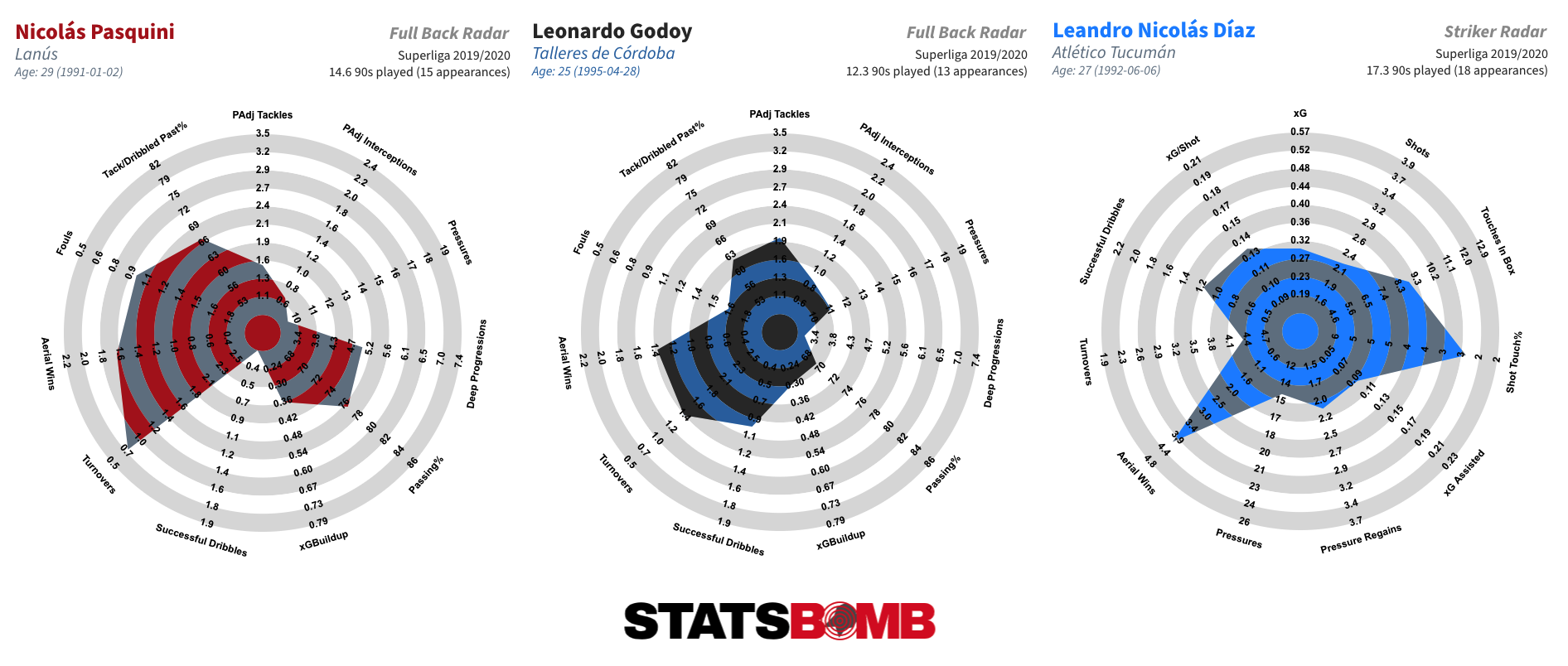 ND: Is there a particular signing you’re interested to see at their new club? VM: Maybe Edwin Cardona at Boca, to see how he fits into the team given that his characteristics, more suited to combination play, seem, in theory, pretty incompatible with Russo’s style of play. At San Lorenzo, it will be interesting to see how Franco Di Santo adapts to Argentinian football after spending his entire career outside the country. ND: In recent years, Di Santo has been a striker of few shots and few goals, so he shouldn’t be expected to score a lot. We’ll have to see what kind of role Soso has in mind for him.
ND: Is there a particular signing you’re interested to see at their new club? VM: Maybe Edwin Cardona at Boca, to see how he fits into the team given that his characteristics, more suited to combination play, seem, in theory, pretty incompatible with Russo’s style of play. At San Lorenzo, it will be interesting to see how Franco Di Santo adapts to Argentinian football after spending his entire career outside the country. ND: In recent years, Di Santo has been a striker of few shots and few goals, so he shouldn’t be expected to score a lot. We’ll have to see what kind of role Soso has in mind for him. 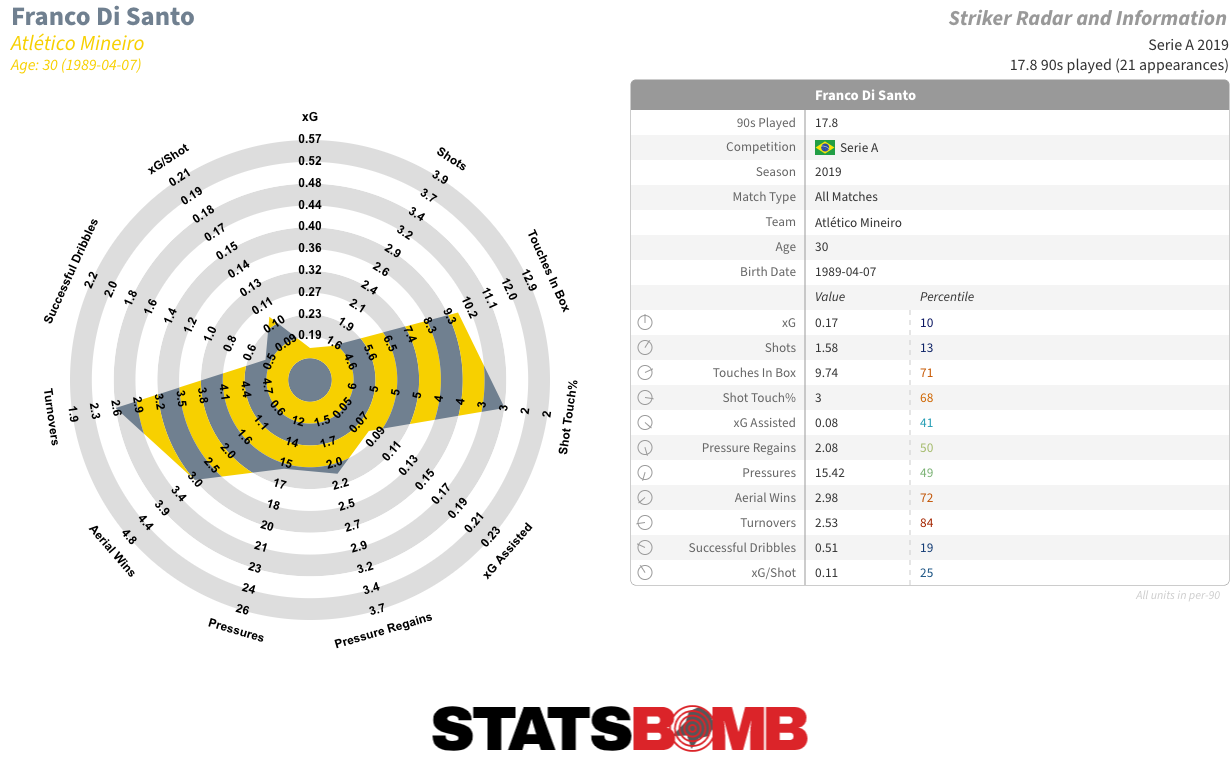 Who are the young players to keep tabs on? VM: At Racing, it will be interesting to see if Benjamin Garré, after showing promise at the back end of last season, is able to secure himself a starting berth and confirm what that run implied, namely that he is a skilled winger, incisive in one-on-one situations. It is obligatory to follow Thiago Almada. The Vélez player is ready to take a further step forward and become what he’s already hinted at becoming: a crack. He’s a skilled dribbler, incisive in one-on-ones, and with a good final pass. He is more than happy to take on the responsibility of generating advantageous positions for his team high up the pitch.
Who are the young players to keep tabs on? VM: At Racing, it will be interesting to see if Benjamin Garré, after showing promise at the back end of last season, is able to secure himself a starting berth and confirm what that run implied, namely that he is a skilled winger, incisive in one-on-one situations. It is obligatory to follow Thiago Almada. The Vélez player is ready to take a further step forward and become what he’s already hinted at becoming: a crack. He’s a skilled dribbler, incisive in one-on-ones, and with a good final pass. He is more than happy to take on the responsibility of generating advantageous positions for his team high up the pitch. 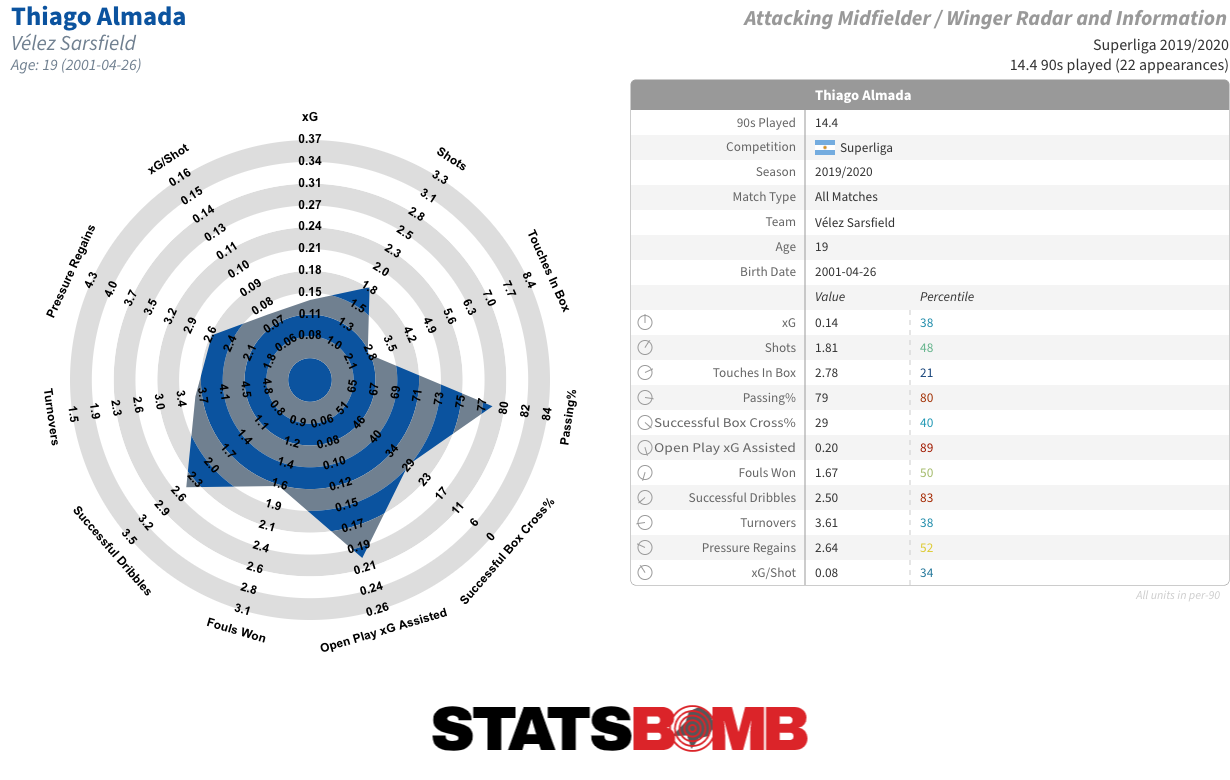 At Argentinos Juniors, Fausto Vera deserves a watch. The central midfielder of the Argentina Olympic team is technically sound, covers a lot of ground and reads play well, qualities that should allow him to establish himself as a great player for his club and also within the league. ND: With three goals and three assists in around 1,100 minutes of playing time, Tomás Badaloni of Godoy Cruz also looks like an interesting player to me. A goal or assist for every 180 minutes on the pitch is very good, particularly given that it runs in line with his expected output. We’ll see if he becomes a more regular starter in this tournament.
At Argentinos Juniors, Fausto Vera deserves a watch. The central midfielder of the Argentina Olympic team is technically sound, covers a lot of ground and reads play well, qualities that should allow him to establish himself as a great player for his club and also within the league. ND: With three goals and three assists in around 1,100 minutes of playing time, Tomás Badaloni of Godoy Cruz also looks like an interesting player to me. A goal or assist for every 180 minutes on the pitch is very good, particularly given that it runs in line with his expected output. We’ll see if he becomes a more regular starter in this tournament.  Great. Well, thanks again for your time Vicente. It's been a pleasure. VM: Thanks to you, Nick, and congratulations on the website. It provides very useful data with which to more deeply analyse the game.
Great. Well, thanks again for your time Vicente. It's been a pleasure. VM: Thanks to you, Nick, and congratulations on the website. It provides very useful data with which to more deeply analyse the game.
2020
Argentina Copa de la Liga Profesional 2020 Season Preview
By admin
|
October 28, 2020
